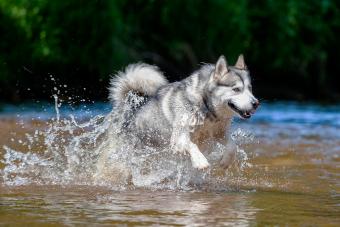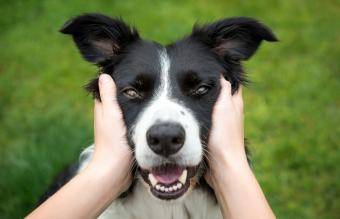
The Alaskan Malamute is a devoted, outgoing breed that enjoys engaging in playful activities and staying active. This could be the breed for you if you're looking for a large breed that's eager to participate in outdoor activities. They're not often suggested for homes with small children or those who don't live an active lifestyle due to the breed's sheer power, enormous physique, and lively disposition.
Where Did the Alaskan Malamute Come From?
Alaskan Malamutes are believed to have descended from dogs that came into North America with Paleolithic tribes around 4,000 years ago, marking their lineage as among the oldest existing breeds. While they have a wolfish appearance, they are not wolves or wolf-dog hybrids, though the breed may have developed in the beginning with some hybrids in their bloodline. Their primary purpose was hauling heavy supplies and helping their owners hunt seals.
Breed Characteristics

Like other spitz breeds, Alaskan Malamutes have the characteristic plumed tail and a compact, sturdy frame. They are powerful dogs that are clearly built for activities requiring strength and endurance. They have broad skulls, small triangular and erect ears, and a long snout. They average 25 inches high at the shoulder and 85 pounds for males and 23 inches high and 75 pounds for females.
The coat ranges from short to medium length with a coarse, heavy topcoat and a dense, wooly undercoat. Their coat is designed for extreme cold temperatures and you can expect these dogs to blow their coats during the warmer months. Their coat also makes them less comfortable in hotter climates. They are definitely a high-shedding breed, so they're not a good choice if you dislike cleaning up dog hair everywhere. Coat colors are a mix of white and gray, black, sable or red, or solid white. They require a bath every one to six weeks and weekly brushings, as matting can occur without regular grooming.
Temperament
Alaskan Malamutes are known for being outgoing, friendly dogs with a puppy-like demeanor. They enjoy playing and are a good pet to have with children, although they are better suited to households with older children because of their size and strength. They can display high prey drive around small animals and may not do well with cats, though some can live with them if raised around felines. They also can be aggressive to other dogs and have been involved in some incidents with aggression to people, though this can often be attributed to poor socialization and care rather than a general trait of the breed. Malamutes are also known for enjoying a good howl and can be "talkative."
Exercise Needs

This breed is definitely not a good choice for a couch potato. Malamutes need a lot of exercise and are high-energy dogs. They can be destructive in the home if they're bored and under-stimulated. They can excel at any type of athletic activity, such as jogging, hiking, skijoring and dog sports such as agility and weight pull. They also love snow and tolerate the cold very well. You may hear Malamute owners complain about how hard it is to get them to come in from frolicking in the snow on an icy winter day.
What's the Difference Between an Alaskan Malamute and a Siberian Husky?
Malamutes and Huskies are often mistaken for each other, and these two distinct breeds share many traits. The Malamute tends to be larger and stockier compared to the leaner and more agile Husky. Their differences are based on their original breeding purpose. Malamutes were designed to pull heavy loads at a slow, steady pace, while Huskies were bred to pull lighter sleds as fast as possible.
Training

Malamutes are known for their keen intelligence and independent nature, which may be more difficult for a first-time owner to handle. Positive reinforcement training is a must, as these dogs need to work in cooperation with you to learn to the best of their ability. They also should be socialized and enrolled in a puppy class as soon as possible so they don't grow into large, uncontrollable adults.
Health Concerns
The Malamute has a lifespan of approximately 10 to 14 years. They have a few medical issues endemic to the breed.
- Canine hip dysplasia is a painful joint and skeletal disorder that tends to affect larger, active dogs such as the Malamute.
- Cataracts are an eye condition which generally affects senior dogs and can damage their vision.
- Gastric torsion (bloat) is a disease that affects deep chested dogs and can be fatal if not treated right away.
- Hemeralopia is an eye disease that causes blindness in bright light, also known as "day blindness."
- Hypothyroidism is a disease of the endocrine system that can lead to weight loss, lethargy and a dull coat and skin conditions.
- Osteochondrodysplasia is a skeletal condition that leads to dwarfism.
- Polyneuropathy is a condition of the nervous system that causes dogs to have difficulty moving and poor coordination. Responsible Malamute breeders will perform a polyneuropathy DNA test on their dogs prior to breeding.
- Seizures are related to epilepsy and are a known problem within the breed.
Where Can You Get an Alaskan Malamute?

If you're looking for an Alaskan Malamute puppy, a good place to start is the website of the Alaska Malamute Club of America (AMCA). They have a breeder directory available for download as an Excel file, as well as helpful tips on how to find responsible breeders with quality dogs. The AKC PuppyFinder page also has a breeder search. Expect to pay around $900 to $1,000, although higher-end show dogs from champion lines can cost as much as $6,500.
You may see some breeders advertising "Giant Alaskan Malamutes," which is not a recognized breed. These dogs are bred to be larger than the standard for the breed, and can weigh as much as 190 pounds, standing up to 35 inches high at the shoulder. This can be problematic for dogs that already suffer from joint issues such as hip dysplasia, as well as other health problems exacerbated by poor breeding and their overly large size.
Reputable Rescue Organizations
If you would prefer a rescued dog, the breeder list on the AMCA website lists breeders who are involved in rescuing the breed. You can also contact these breed-specific Malamute rescues:
- Alaskan Malamute Assistance League is a national clearinghouse for information on dogs needing homes that is affiliated with the national breed club.
- Moonsong Malamute Rescue rescues and places dog in Idaho, Montana, Northern Nevada, Utah and Wyoming.
- Washington Alaskan Malamute Adoption League rescues and places dogs in Washington state, as well as Idaho and Oregon.
- Polaris Alaskan Malamute Rescue helps dogs in Colorado and surrounding states.
- Alaskan Malamute Rescue of New England places dogs in the New England area.
Is This Breed Right Dog For You?
If you are an active person who wants a high-energy, intelligent companion who loves cold climates, the Alaskan Malamute is an excellent choice. They're not the best breed for apartments, those with sedentary lifestyles, homes with small children and pets, or for people who are not keen on dealing with lots of dog hair. Training and socialization is also a must, so you should be willing to put in the time to be a responsible Malamute owner before bringing one home.







